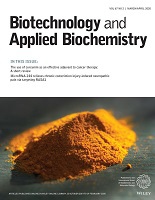Immobilized peptide-N-glycosidase F onto magnetic nanoparticles: a biotechnological tool for protein
Dublin Core
Título
Tema
Abstract
The elucidation of glycans biological function is essential to
understand their role in biological processes, both normal and
pathological. Immobilized glycoenzymes are excellent tools
for this purpose as they can selectively release glycans from
glycoproteins without altering their backbone. They can be
easily removed from the reaction mixture avoiding their
interference in subsequent experiments. Here, we describe the
immobilization of peptide-N-glycosidase F (PNGase F) onto
silica magnetic nanoparticles with immobilization yields of
86% and activity yields of 12%. Immobilized PNGase F showed
higher thermal stability than its soluble counterpart, and could
be reused for at least seven deglycosylation cycles. It was
efficient in the deglycosylation of several glycoproteins
(ribonuclease B, bovine fetuin, and ovalbumin) and a protein
lysate from the parasite Fasciola hepatica under native
conditions, with similar performance to that of the soluble
enzyme. Successful deglycosylation was evidenced by a
decrease in specific lectin recognition of the glycoproteins
(40%–80%). Moreover, deglycosylated F. hepatica lysate
allowed us to confirm the role of parasite N-glycans in the
inhibition of the lipopolysaccharide-induced maturation of
dendritic cells. Immobilized PNGase F probed to be a robust
biotechnological tool for deglycosylation of glycoproteins and
complex biological samples under native conditions.
Fuente
Editor
Fecha
Derechos
Información sobre Derechos de Autor
(Por favor lea este aviso antes de abrir los documentos u objetos)
La legislación uruguaya protege el derechode autor sobre toda creación literaria, científica o artística, tanto en lo que tiene que ver con sus derechos morales, como en lo referente a los derechos patrimoniales con sujeción a lo establecido por el derecho común y las siguientes leyes (LEY 9.739 DE 17 DE DICIEMBRE DE 1937 SOBRE PROPIEDAD LITERARIA Y ARTISTICA CON LAS MODIFICACIONES INTRODUCIDAS POR LA LEY DE DERECHO DE AUTOR Y DERECHOS CONEXOS No. 17.616 DE 10 DE ENERO DE 2003, LEY 17.805 DE 26 DE AGOSTO DE 2004, LEY 18.046 DE 24 DE OCTUBRE DE 2006 LEY 18.046 DE 24 DE OCTUBRE DE 2006)
ADVERTENCIA: La consulta de este documento queda condicionada a la aceptación de las siguientes condiciones de uso: Este documento es únicamente para usos privados enmarcados en actividades de investigación y docencia. No se autoriza su reproducción con fines de lucro. Esta reserva de derechos afecta tanto los datos del documento como a sus contenidos. En la utilización o cita de partes debe indicarse el nombre de la persona autora.Formato
Idioma
Tipo
Identificador
Document Item Type Metadata
Original Format
- Fecha de agregación
- April 5, 2022
- Colección
- Bibliografía Nacional Química
- Tipo de Elemento
- Document
- Etiquetas
- Analisis Glicómico, Desglicosilación, Glicanos, Glucosidasa, Inmovilización enzimática, Nanopartículas, Péptidos
- Citación
- Bidondo, Lucía, “Immobilized peptide-N-glycosidase F onto magnetic nanoparticles: a biotechnological tool for protein,” RIQUIM - Repositorio Institucional de la Facultad de Química - UdelaR, accessed August 25, 2024, https://riquim.fq.edu.uy/items/show/6476.
- Archivos

